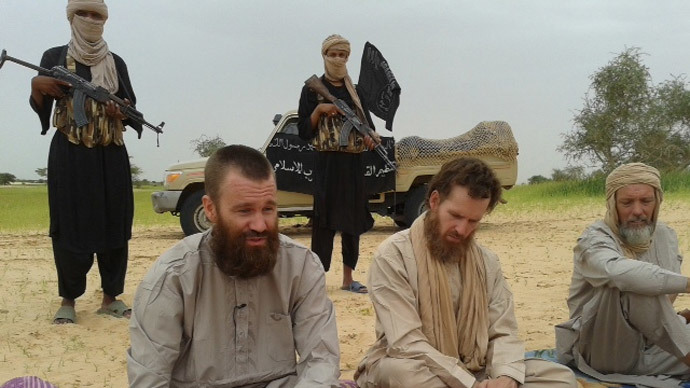Global terrorism, insurgency attacks surge 150% in 5 years – report

The number of terrorist and insurgency attacks worldwide has increased by more than 150 percent since 2009, driven in large part by suicide attacks in Iraq and an ongoing civil war in Syria.
Riding on a wave of violence, notably across a large swathe of
the Middle East that began with the so-called Arab Spring in
December 2010, terrorism and insurgents have witnessed a sharp
increase in the last five years.
“In 2009, a worldwide total of 7,217 attacks were recorded
from open sources. In 2013, that number increased by more than
150 percent to 18,524,” said Matthew Henman, manager of IHS
Jane’s Terrorism and Insurgency Centre (JTIC), the organizers of
the study.
The highest rate of violence last year was reported in the Middle
East, with major “pockets of violence” moving like a
contagion to parts of Africa and South Asia.
This movement led to a dramatic rise in the number of militant
and non-militant casualties.
In 2012, the deaths of 13,872 militants and 10,562 non-militants
were recorded from public sources. Last year, non-militants
fatalities nearly doubled to 17,554, while militant fatalities
were reported at 21,490.
“These are some of the largest rises we have recorded in the
past several years,” Henman said.
Jane’s defines an attack as any event in which a sub-state actor,
whether an individual, individuals or organization, commits
politically or ideologically motivated acts of violence with the
goal of coercing others to adopt or comply with their objectives
or to submit to their authority, that results in death, damage,
or disruption.
A single spark
It is tempting to blame at least part of the surge in regional
violence on a single individual, Mohamed Bouazizi, a Tunisian
street vendor who immolated himself on December 17, 2010 to
protest what he believed was ill treatment at the hands of local
officials. His death became a catalyst for the Tunisian
Revolution, which stoked the fires of what came to be known as
the Arab Spring.
Following the 2011 overthrow of Tunisian President Zine
al-Abidine Ben Ali, the revolutionary fires spread to Egypt,
where millions of protesters demanded the overthrow of Egyptian
President Hosni Mubarak and his regime. Violent clashes broke out
between security forces and protesters resulted in 846 people
killed and tens of thousands injured.
Violence and political upheaval continues to plague both Arabic
nations, the report noted
“In 2013, JTIC recorded a spike in activity by non-state
armed groups in Tunisia and Egypt. Attacks in Tunisia grew from
21 in 2012 to 72 in 2013. In Egypt, the number of attacks
recorded jumped from 63 in 2012 to 431 in 2013.”
Violent protests erupted once again in June 2013 following the
toppling of President Muhammad Morsi, who replaced Mubarak just
over a year earlier. Egyptian violence accounted for “the
majority of sub-state violence recorded by JTIC,” Henman said.
In Libya, meanwhile, which suffered an 8-month civil war in 2011
that led to the toppling of strongman Muammar Gaddafi, there were
237 attacks recorded in 2013, up from 81 in 2012.
Syria and Iraq smoldering
Syria, where rebel and Islamist forces have been attempting to
oust the government of President Bashar Assad since March 15,
2001, has witnessed a two-fold increase in attacks between 2012
and 2013.
“Due to a plurality of factors, the anti-government
insurgency in Syria intensified notably in 2013,” the report
read. “Between 2012 and 2013, the number of attacks recorded
by JTIC almost doubled. In 2012, we recorded 2,670 attacks. In
2013, that number jumped to 4,694.”
Meanwhile, Iraq, struggling to get back on its feet after a
nearly nine-year-long occupation of its territory by US-led
forces, is coming under a barrage of suicide attacks.
“A key indication of the intensifying level of violence in
Iraq was that the number of suicide attacks in the country
quadrupled from 2012 to 2013, with the 2013 total almost triple
that recorded in neighboring Syria and almost double that
recorded in Afghanistan,” the report said.
In 2013, 207 attacks were believed to be carried out by Al-Qaeda
in Iraq (AQI), which represents a 160 percent jump from the 79
recorded in public sources in 2012.
The report pointed to the “AQI’s predominant role” behind the 52
percent increase in the recorded number of attacks in Iraq and
the 148 percent surge in non-militant fatalities.
“In 2012 there were 2,297 attacks in Iraq. At the end of
2013, that figure stands at 3,499,” the report said.
For RT's report on Iraq carnage, click here.
World of Warfare: Top 10 most active non-state armed groups in 2013
1. Barisan Revolusi Nasional (Thailand)
2. Taliban
3. Islami Chhatra Shibir (Bangladesh)
4. Communist Party of India – Maoist
5. Al-Qaeda in Iraq
6. Harakat al-Shabaab al-Mujahideen (Al-Shabaab)
7. FARC (Colombia)
8. New People’s Army (Philippines)
9. Jabhat al-Nusra (Syria)
10. Unified Communist Party of Nepal – Maoist
Source: IHS Jane’s Terrorism and Insurgency Centre














